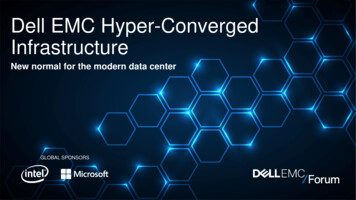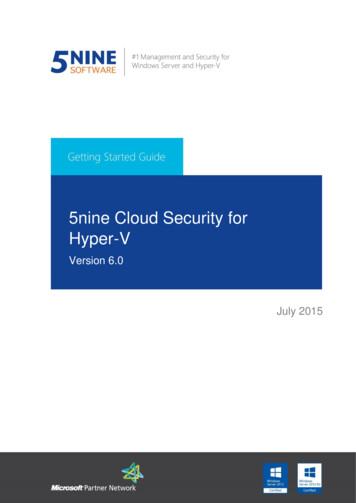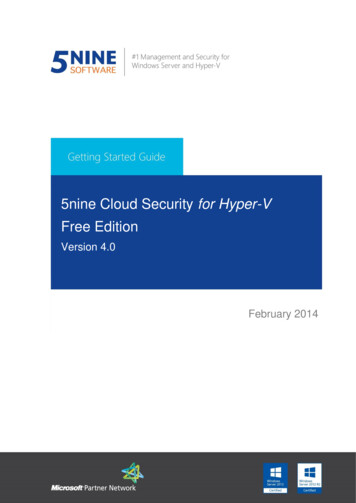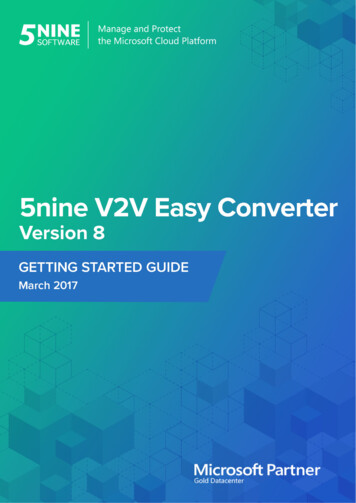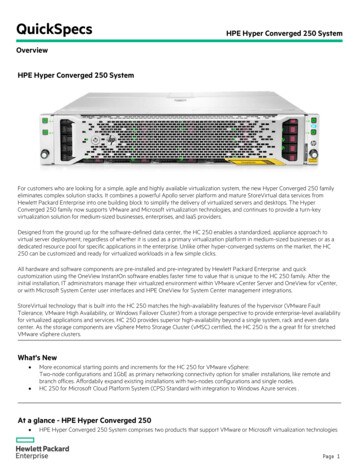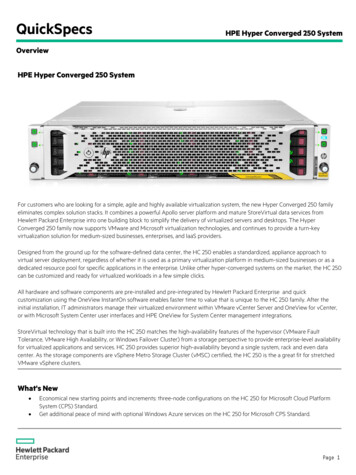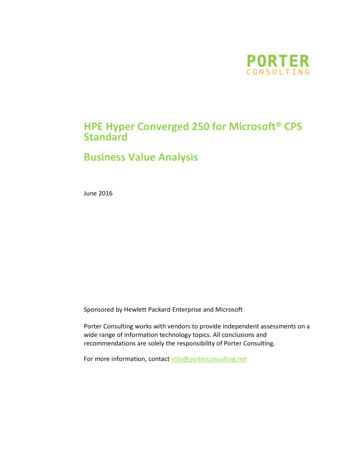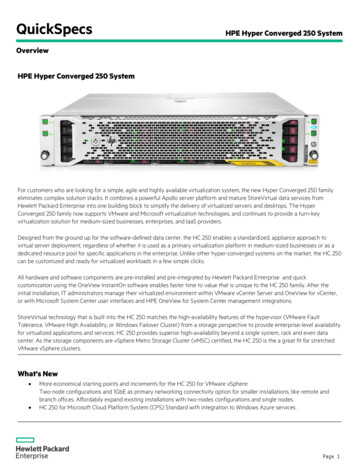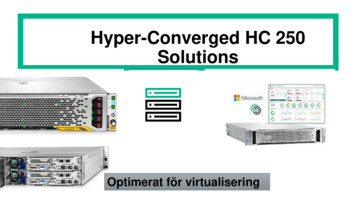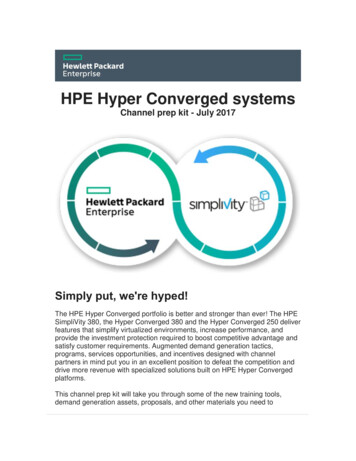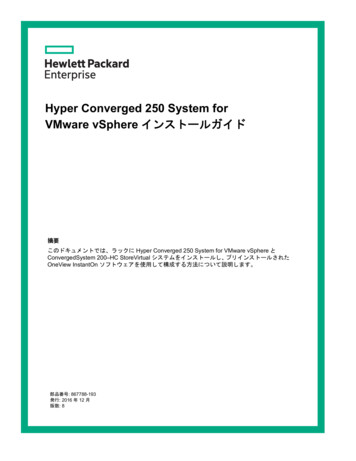
Transcription
HyperIP Accelerates Hyper-V Live MigrationOA DeepStorage.net Labs Validation Reportver the past few years organizations have been adopting server virtualizationto reduce capital expenditures by consolidating multiple virtual servers ontoa single physical server. Once they’ve begun the process, organizations soondiscover that the ability to migrate running virtual servers from one host to anotherfor maintenance or load balancing increases their operational efficiency as much asserver consolidation reduces capex.To date, this flexibility has been limited to moving virtual guest servers between hostsin the same data center as hypervisor vendors like VMware and Microsoft have onlysupported live migration over dedicated, high bandwidth, low latency connections.NetEx’s HyperIP is a virtual appliance that accelerates TCP/IP protocols andapplications on WAN links by reducing the impact of latency and packet loss makingmore of the network’s bandwidth usable. A HyperIP virtual appliance can accelerateup to 800Mbps of TCP traffic.NetEx hired DeepStorage Labs to validate that HyperIP virtual appliances canaccelerate the live migration of a virtual Windows server over typical WAN linksbetween data centers.The Bottom LineCorporations with multiple geographically dispersed data centers want to easilymigrate virtual machines between locations. While Hyper-V Live Migration is a goodsolution for server migration, it is too slow over all but the shortest links. The problemisn’t a lack of bandwidth but the inefficient way TCP connections handle latency. Wetested NetEx’s HyperIP WAN acceleration software and found: HyperIP accelerates Live Migration across WAN links up to 16X HyperIP accelerated migration times, even over low-cost networks, arecomparable to migrations within the data center HyperIP’s virtual appliance architecture requires minimal changes to theunderlying network simplifying implementation and reducing cost HyperIP is a valuable addition to the system architect’s bag of tricks whendata or virtual systems are transferred between locations for disasteravoidance or other purposesALabs Validation Report June 2010Copyright 2010 DeepStorage.net. All Rights Reserved
HyperIP Accelerates Hyper-V Live MigrationWhat We DidTo test how sensitive Hyper-V Live Migration is to WAN impairments like latencyand packet loss, and how much HyperIP could ameliorate the impact thereof, wemigrated a Windows Server 2003 web server between a pair of Hyper-V host systemsacross a WAN emulator. The WAN emulator was configured to provide bandwidth,latency and other conditions consistent with the links medium and large enterpriseswould use between data centers. The impairments used were based on publishedservice level agreements from carriers providing these services.The emulated links used were:Type of Link EmulatedNetwork ConditionsBandwidth, Round Trip Latency, Packet Loss, JitterBaseline1Gbps, none, none, noneLow Latency Sonet link(NY-Jersey City)1Gbps, 5MS, .001%, noneLow Latency Metro Ethernet1Gbps ,5MS, .005%, noneMetro Ethernet1Gbps, 12MS, .1%, noneMPLS VPN(NY-Chicago)100Mbps, 25MS, .05%, 3MSNote: These are the same conditions used in our previous report for NetEx using VMotion.Baselinew/HyperIPUnacceleratedSonetLL Metro EthernetMetro EthernetMPLS050100150200250300350400450Live Migration Time(in seconds)ALabs Validation Report June 2010Copyright 2010 DeepStorage.net. All Rights Reserved
HyperIP Accelerates Hyper-V Live MigrationWhat We FoundAs expected, we found that regardless of the bandwidth available, Live Migrationperformance fell off dramatically as latency and/or packet loss were introducedto the emulated WAN link. HyperIP significantly boosted Live Migration speed onall but the best of our emulated WAN links. In fact, HyperIP accelerated migrationperformance was comparable to the baseline – even on reduced bandwidth links withsubstantial impairments.Other than on our baseline test, where processing the data through HyperIP addeda few seconds to the migration time, HyperIP reduced Live Migration time acrossthe board. Regardless of network conditions, HyperIP enabled Live Migrations tocomplete in less than 30 seconds while suffering fewer and shorter outages than theun-accelerated case.We were most impressed with the results on the 100Mbps emulated MPLS link wheremigrating our test server took 1/17th the time with HyperIP than it did without. Whilea higher bandwidth link would be preferred, this demonstrates that migration acrossslower links is possible and exceeds the vendor’s claim that their product increasestransfer rates by a factor of up to six.The Test ConfigurationHP ProLiant ML115g5HP Pr oLia nt M L110g3WebstressSystemUsersVMware HostVMware HostU ID12HPP ro Lia n tU IDDL160 G612HPP ro Lia n tDL160 G6DL160 G6DL160 G6HyperIP VMHyperIP VMEmulated WAN Link 1WebServerVMLive Migration of Web ServerWebServerVMP o we r E d g e 2 9 5 0253647P o we r E d g e 2 9 5 00250361471PowerEdge 2950PowerEdge 2950Hyper-V HostHyper-V HostMPIO iSCSI connectionsHPProLiantDL180 G6HPProLiantDL180 G6UID121UID21212Emulated WAN Link 2iSCSI Network HyperIP omitted for clarityALabs Validation Report June 2010Copyright 2010 DeepStorage.net. All Rights Reserved
HyperIP Accelerates Hyper-V Live MigrationTest Result Data(in seconds)BaselineSonetLow LatencyMetro 27.5395.2w/HyperIP9.912.913.714.722.9The TCP ProblemThe Transmission Control Protocol (TCP) provides assured delivery of data by having the receiving node acknowledge the receipt of data packets and having thesending station retransmit packets when it hasn’t received an acknowledgement inthe allowed time. While TCP provides reliable communications, it was designed in the1970s and has difficulty effectively using today’s networks, which are much faster, andless error-prone.The biggest issue is that TCP can typically only send 64KB before it receives an acknowledgement from the destination station. Since 64KB takes only ½ millisecond totransmit across a gigabit link, even 1MS of round trip latency could cut TCP performance across a metro Ethernet connection by a factor of four.TCP’s designers assumed that the network on which it would run would be both slowand congested. As a result, TCP sessions start slow and ramp up their data rate. TCPalso assumes all packet losses are the result of congestion so it starts the slow rampup again with each lost packet resulting in more idle time on the link.This is reflected in our test results as adding 5MS of one-way latency and a moderate .005% packet loss extended Live Migration times 56% even with a full 1Gbps linkavailable.How HyperIP WorksHyperIP boosts the effective bandwidth of WAN links using two basic techniques.First it terminates the TCP connection from the applications at each end of theconnection at the HyperIP virtual appliance. Since these TCP connections run acrossshort, and essentially error-free LAN links, TCP can fill the available bandwidth.Second, it sends the data across the WAN link between a pair of HyperIP software virtual appliances using UDP, which is not latency sensitive. NetEx adds a proprietarydata delivery protocol to UDP which adjusts the amount of data “in flight” and theblock size to accommodate changing WAN conditions.Rather than assuming that all packet loss is due to link congestion, HyperIP managesthe link adjusting the rate at which it sends data to match varying line conditions.In addition, HyperIP compresses data before segmenting it into packets to send acrossthe net so each packet can be sent at the optimal size. It also monitors the effectiveness of the compression algorithm disabling compression when the compressed data ismore than 80% the size of the source data.ALabs Validation Report June 2010Copyright 2010 DeepStorage.net. All Rights Reserved
HyperIP Accelerates Hyper-V Live MigrationHow HyperIP WorksAbout DeepStorage.netDeepStorage is dedicated to providing independent information on storage and other insidethe data center technologies to help organizations solve real world problems. Our 25 yearsof experience testing, writing about and most importantly implementing systems in the realworld informs everything we do, leading to the development of our hands-on philosophy.Our lab is at the heart of the hands-on philosophy providing a facility where we evaluatehardware and software products away from the influence of the vendors. We performvalidation, usability, power use and performance testing in individual and competitivetests for publication and the private use of our clients. Our reviews have appeared in majorpublications including Network World, Network Computing and InformationWeek.The lab is equipped with the latest networking gear, including FCoE, and multi-processorservers from IBM, Dell and HP allowing us to test applications under Windows and Linux,including virtual server environments. We believe a mix of real world and synthetic testingreveals more than either alone. We also use dedicated test equipment from Spirent, Apposite,Shunra and others to provide repeatable testing.The Test EnvironmentAll testing was performed at DeepStorage Labs in Lyndhurst, NJ. DeepStorage.net determined all test parameters and no NetEx personnel were present during testing.A pair of Dell PowerEdge 2950 servers were configured as a Windows Server 2008 R2 clusterwith Cluster Shared Volumes. Each was configured with separate gigabit Ethernet controllersfor the user network, iSCSI storage and Live Migration. Storage was provisioned on a DellPowerEdge 1850 server and an HP DL380 G5 using the StarWind iSCSI target for Windowscreating a high availability cluster.An Extreme Summit 7i gigabit Ethernet switch was used with multiple vlans. Apposite Linktropy 7500 PRO was used to emulate WAN links for both the Hyper-V Live Migration link andthe iSCSI network link between the two simulated data centers. A system running Paessler’sWeb Server Stress Tool was continuously accsessing the web server as it was migrated acrossthe emulated link.ALabs Validation Report June 2010Copyright 2010 DeepStorage.net. All Rights Reserved
To test how sensitive Hyper-V Live Migration is to WAN impairments like latency and packet loss, and how much HyperIP could ameliorate the impact thereof, we migrated a Windows Server 2003 web server between a pair of Hyper-V host systems across a WAN emulator. The WA
